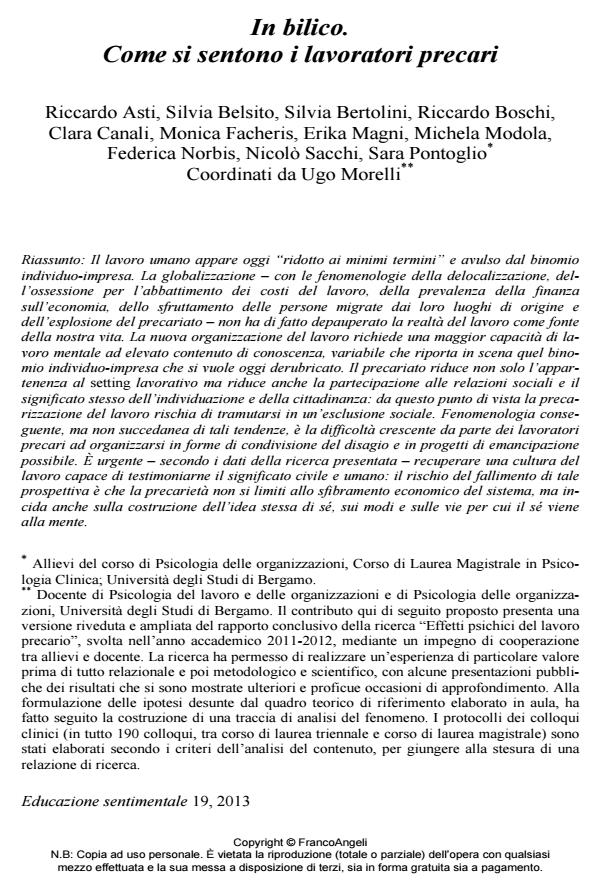In the balance. How do they feel temporary workers
Journal title EDUCAZIONE SENTIMENTALE
Author/s Riccardo Asti, Silvia Belsito, Silvia Bertolini, Riccardo Boschi, Clara Canali, Monica Facheris, Erika Magni, Michela Modola, Federica Norbis, Nicolò Sacchi, Sara Pontoglio, Ugo Morelli
Publishing Year 2013 Issue 2013/19
Language Italian Pages 20 P. 68-87 File size 722 KB
DOI 10.3280/EDS2013-019008
DOI is like a bar code for intellectual property: to have more infomation
click here
Below, you can see the article first page
If you want to buy this article in PDF format, you can do it, following the instructions to buy download credits

FrancoAngeli is member of Publishers International Linking Association, Inc (PILA), a not-for-profit association which run the CrossRef service enabling links to and from online scholarly content.
Human labour is now reduced to a minimum and detached from the combination of individual and firm. Globalization - with the phenomena of relocation, of obsession with the reduction of labour costs, of the prevalence of finance on the economy, the exploitation of people who have migrated from their places of origin and the explosion of insecurity - not has effectively depleted the reality of work as the source of our life. The new organization of work requires a greater capacity for mental work with a high knowledge content, variable bearing on stage that combination of individual company we want today declassified. The insecurity reduces not only membership in the work setting, but also participation in social relationships, and the significance of the identification and citizenship: from this point of view, job insecurity is likely to turn into a social exclusion. Resulting phenomenology, but not a substitute for these trends, is the increasing difficulty by temporary workers to organize themselves in ways of sharing the discomfort and possible projects of emancipation. It is urgent - according to the research data presented - retrieve a work culture that can testify to the civil and human significance: the risk of failure of this perspective is that the uncertainty is not limited to the shredding of the economic system, but also affect on construction of the idea of self, the ways and the ways in which the self comes to mind.
Keywords: Individual, firm, human labor, globalization, relocation, job insecurity, social exclusion, Self, loss of self, persecutory and depressive anxieties, mind.
Riccardo Asti, Silvia Belsito, Silvia Bertolini, Riccardo Boschi, Clara Canali, Monica Facheris, Erika Magni, Michela Modola, Federica Norbis, Nicolò Sacchi, Sara Pontoglio, Ugo Morelli, In bilico. Come si sentono i lavoratori precari in "EDUCAZIONE SENTIMENTALE" 19/2013, pp 68-87, DOI: 10.3280/EDS2013-019008